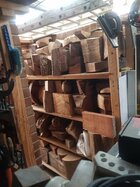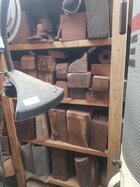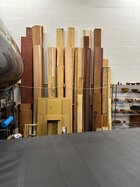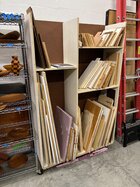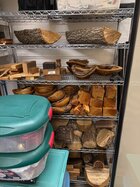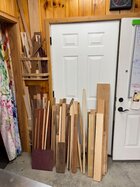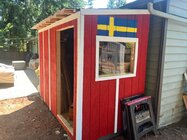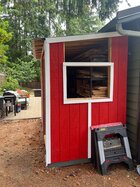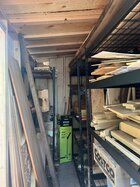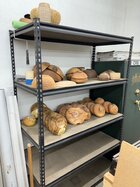I am building a new turning studio. I acquired 600 pounds of dried exotic and local hardwoods most of which are no bigger that 10x10x3. Really nice stuff, Purple Heart, Cocobola, Redwood Burl, Tulip wood, Paduk, Bloodwood, Pink Ivory, etc. But there are also, numerous small 2x2s, pen blanks and other pieces and shorts. ..
... Next, I'm trying to make this an attractive work space, I would love to see your solutions for storing your small and often exotic wood stock in an attractive manner. I also have concerns about light exposure and cracks to these exotics, should I be concerned? Would I be better off having at least the exotics in a closed cabinet? Yes, cracks can be filled, I just want to protect my investment.
Hey Todd.
I store a lot of wood in my shop, lots of large and small domestics I cut from green and dry wood, and a bunch of exotics of various sizes. Be aware that many exotics are not dry and for several reasons it's difficult to judge the moisture content from a meter. Most exotics come coated in wax but that may mean nothing. One wood dealer I know dips most wood in hot paraffin since it may not be dry and regardless, it might make it look better - can't assume any wood is wet or dry unless you cut and dry it yourself. I did use the oven dry test to check a big batch of ebony - it's a destructive method that needs a small piece cut from the wood but it's the gold standard for determining MC.
I put nothing in closed spaces. It's been years since I've seen a crack on an exotic blank.
I'm not so sure the temperature makes as much difference as the humidity. There are tables of the relationship. My shop has heat and air - I set the thermostat to about 60 or so in the winter and maybe around 78 the summer (saves on energy costs and still feels comfortable to me) The humidity stays reasonably constant.
Processing green wood and drying.
When processing log sections into blanks, I apply anchor seal to all end grain, and in certain cases (too much to describe here) I seal one or more side faces. In over 15 years of doing this I've lost almost none from checking or cracking, even for quite large blanks (10x10x16"). I have a video here in the Tutorials and Tips sub-forum which describes some of this.
One thing about anchor seal - to me it's too thin for effective use with green wood. I pour a little into a coffee can and leave the lid off for several days. This allows some of the moisture to evaporate and makes the anchor seal thicker - it goes on thicker and protects better. (Since it's made of wax emulsified with water it's adding a second coat later doesn't work so well.) I apply the sealer with a cheap brush I keep in the can.
Pictures of some smaller blanks drying.
 On the right is a stack of green wood fresh from a bandsaw session.
On the right is a stack of green wood fresh from a bandsaw session.
I cut logs up into the largest pieces I can get then cut small blanks from what's left over.
Monitoring moisture content
To monitor the state of dryness I put a piece of tape on a typical blank or two in the batch, weigh those pieces with a sensitive scale, and record the date (month/year) and the weight in grams. Ever few months I make a circuit around the storage areas, weigh again and again record the weight and current date. If the wood is not completely dry, the weight will drop some (assuming the humidity in the storage area hasn't gone crazy). When the weight quits dropping over several periods (or if it has gone up a ttiny bit, indicating some seasonal change) I pronounce the wood dry and write so on the label. I don't monitor every piece but just a few typical ones about the same size/thickness as others, If I have various sizes, I assume that when the larger pieces are dry, the smaller sizes are also dry.
Some big pieces take years to dry. Can't get in a big hurry. It's more fun than watching paint dry.
Monitoring drying by weighing, both domestic and exotics.

This monitoring method has served me well for many years, both with exotics and blanks I cut from domestic green log sections. Having the dry wood is important to me since the things I like to turn the most are best made from dry wood.
Storing wood, wet and dry.
I store several ways. For some domestic species I've cut from green wood, I'll store the smaller pieces loosely in plastic tubs. They get enough air circulation and dry quickly. I always store large blanks (sizes say from 4x4" up to 10x10") and most other blanks on wire shelf units 6' tall, 4' wide, and 18" deep. My shop ceilings are 10' so there is plenty of space on the top of each one. I think I have at least a dozen of these shelf units and they are mostly full. I store big stuff like planks and slabs leaning up against walls.
Sorry, the idea of the "attractive work space" is foreign to me! Not on my radar.

(I should point out that I don't surround the lathes and other working areas with wood.) When I built my shop I designated areas for wood storage and a large area in separate room. I also store wood in several out-buildings and an enclosed trailer on the farm. Maybe I might have too much wood... Nah. I did an inventory once and had over 120 species - a friend laughed at me and said his count was over 300. I never knew it was a contest! (He keeps spreadsheets with every piece, size, date, cost, place of purchase. Yikes)
I stand most large blanks on end on a wire shelf. If space is tight, I might lay put large pieces in layers separated by some smaller square blanks as "stickers" for free air circulation. I never put a blank that is not completely dry directly in contact with other wood without separators.
After wood is dry, I either stack it tighter or dump into tubs and store them on the floor. I use a lot of tubs. Again, about an attractive work space - I think wood is beautiful regardless of how it's stored.
For long dry blanks, say 2x2s longer than 15" or so, I put them on the upper shelves of the racks and put a sticker on the end with two things: the species name and the length. That way I can look at the shelf and if I need, say, a piece of dogwood 18" long I won't waste time pulling out shorter pieces!
I store shorts in smaller tubs on shelves.
Pictures of misc wood storage, organized by my secret code.
There is always plenty to give to friends and students.
When I kick the bucket some day, imagine the bonfire this would make.
 This area is mostly exotics, some drying, some dry.
This area is mostly exotics, some drying, some dry.
Tubs on floor are mostly dry domestic wood, waiting to be adopted.

I'm not so sure the temperature makes as much difference as the humidity. There are tables of the relationship. My shop has heat and air - I set the thermostat to about 60 or so in the winter and maybe around 78 the summer (saves on energy costs and still feels comfortable to me) The humidity stays reasonably constant.
Sorry, in addition to having a serious wood problem, I'm a certified photo maniac and ought to be locked away.
JKJ


